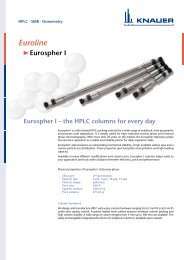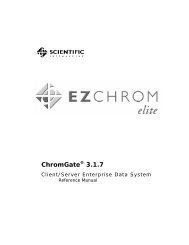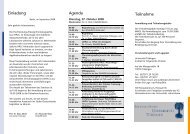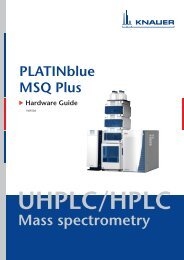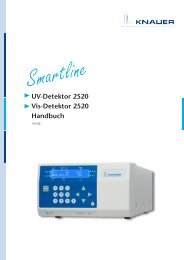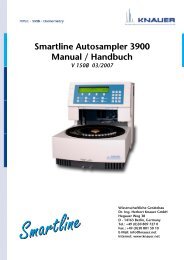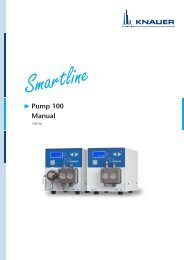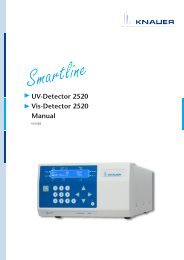ChromeGate 3.3.2 Software Manual - KNAUER Advanced Scientific ...
ChromeGate 3.3.2 Software Manual - KNAUER Advanced Scientific ...
ChromeGate 3.3.2 Software Manual - KNAUER Advanced Scientific ...
Create successful ePaper yourself
Turn your PDF publications into a flip-book with our unique Google optimized e-Paper software.
PDA Analysis and Calculations 225<br />
Upslope and Down slope Spectra<br />
The upslope and down slope spectra of a peak are identified by<br />
calculating the second derivative of the portion of the chromatogram<br />
containing the peak. The two times at which the second derivative plot<br />
crosses zero are known as the inflection points. For normal peaks (i.e.<br />
non-Negative peaks), the Upslope Spectrum is the spectrum at the time<br />
represented by the first inflection point, while the Down slope Spectrum is<br />
the spectrum at the time represented by the second inflection point.<br />
Library Search Calculations<br />
General<br />
Pre-Filters<br />
During analysis, if one or more search libraries are defined on the Library<br />
tab of PDA Options, then an automated library search is performed on<br />
every integrated peak of every PDA analysis channel.<br />
Unless a Library Search Results object is part of the method custom<br />
report, no automated library searching will done when analysis is<br />
performed.<br />
In this section, a Query Spectrum is defined the unknown spectrum that<br />
is being searched. A Reference Spectrum is defined as a spectrum from<br />
a spectrum library file.<br />
During a search, the apex spectrum of the peak (the query spectrum) is<br />
compared to each spectrum contained in the libraries (reference spectra)<br />
to determine the similarity of the query spectrum to the reference<br />
spectrum. The similarity is quantified through the calculation of a<br />
Similarity Index for each query/reference pair. The Similarity Indices are<br />
used to generate a hit list of the best matching entries. A perfect match<br />
will have a Similarity Index of 1.0000. Similarity indices less than 1<br />
indicate differences in the spectral patterns.<br />
If the query spectrum and the reference spectrum have different<br />
wavelength ranges, then the intersection of the two ranges is used in the<br />
similarity calculation.<br />
If the query spectrum and the reference spectrum have different<br />
wavelength steps, then the higher resolution spectrum is de-resolved to<br />
match the other spectrum before being used in the similarity calculation.<br />
A pre-filter is a criterion on a reference spectrum that must be met before<br />
that spectrum is used in similarity calculations. One or more pre-filters<br />
may be specified in the search parameters. When multiple pre-filters are<br />
specified, a reference spectrum must meet all of the individual pre-filters<br />
in order to be considered for similarity calculations.<br />
Reference spectra that do not meet all of the pre-filter criteria are<br />
automatically excluded from calculations and from being a candidate for a<br />
hit list. No similarity calculation is performed on these spectra.<br />
The following pre-filters are supported:<br />
Retention Time Range<br />
When a Retention Time Range is specified, a reference spectrum is<br />
excluded unless the retention time for the spectrum in the library is within<br />
the specified range.<br />
Lambda Max<br />
Up to three Lambda Max values may be specified. When one or more<br />
Lambda Max values are specified, a reference spectrum is excluded





